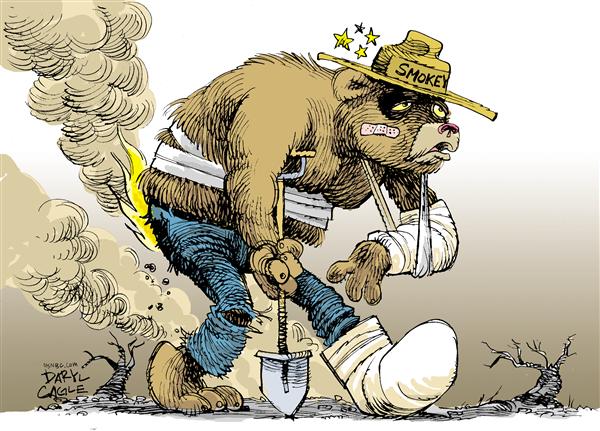Editor’s note: This editorial was written by Joe Guzzardi. He is a Californians for Population Stabilization Senior Writing Fellow. Contact him at joeguzzardi@CAPSweb.org.
 From ecological, financial, and social perspectives, my native California has had a rough year, and 2018 may not be better.
From ecological, financial, and social perspectives, my native California has had a rough year, and 2018 may not be better.
Ecologically, the worst disaster to hit California is the Thomas Fire which started [Monday,] December 4[, 2017]. Nearly 90 percent contained at the time of this writing, Thomas has destroyed an area equal to Miami and Dallas. Thomas caused major financial and personal losses and continued a wildfire destruction pattern that started five years ago. The third-largest wildfire since 1932, Thomas has destroyed more than 1000 homes, businesses, and other structures.
Because of intense smoke from October wildfires in Northern California, air pollution there reached historically high levels. The Bay Area was hit hard, and, in Napa, air quality was off the charts of the Bay Area Air Quality Index…past “very unhealthy.”
Beyond the havoc wildfires wreaked, average Californians struggled to keep up with mounting costs, especially in the most basic commodity, housing. Affordable housing in California has always been scarce, but today, an average home costs $440,000, roughly two-and-a-half times the average $180,000 National home price. California’s average monthly rent is about $1240. This is 50 percent higher than the rest of the Country. Home ownership is out of reach for many Californians; less than 54 percent of homes are occupied by their owners, the U.S.’s 49th lowest percentage.
High rents have led to a dramatic spike in homelessness. A 2017 San Francisco Chronicle story revealed that California homelessness has risen 15 percent since 2015. The increase may not be surprising in Los Angeles or other heavily populated urban centers. But rural homelessness shocked analysts: El Dorado and Butte Counties rose 122 percent and 76 percent, respectively. Those and other counties like Shasta, Imperial, and Lake have neither the funding nor the personnel to deal with needs of the homeless. Overwhelmed churches and charities can’t keep up.
California is also at the bottom of the barrel in income and quality-of-life inequality. Measure of America social science researchers found that in booming Silicon Valley, life expectancy is 83.7 years, and a typical resident earns $55,215 a year. A lofty 86 percent of younger residents are enrolled in school, and 60 percent of those age 25 and older have at least a Bachelor’s degree. But less than a 100 miles southeast in the San Joaquin Valley’s lower half, life expectancy is 78.4, and median income is $20,100. Only 73.5 percent of younger residents attend school, and a mere 8.3 percent earn a Bachelor’s degree.
Most Californians found 2017’s final indignity its Sanctuary State status. Before Governor Jerry Brown defiantly signed the bill in October which passed the California Assembly but never appeared on a ballot, University of California polling showed that 70 percent of voters from both major parties, and across all demographic strata, opposed sanctuary cities.
Two months later, a San Francisco jury cleared five-time deported, seven-time convicted, illegal alien, felon Jose Ines Garcia Zarate of murder charges, that stemmed from his 2015 shooting of Kate Steinle. The jury’s not guilty decision outraged the Nation.
In 2018, California will elect a new Governor who will likely continue Brown’s legislative pro-illegal alien, anti-President Donald Trump legislative path. And next year, 84-year-old incumbent U. S. Senator Dianne Feinstein–who has been in Congress for 25 years and in Government most of her adult life–is expected to be easily re-elected.
Given that a change in California’s leadership philosophy is improbable, so too is it unlikely that there will be a reversal of the State’s rapidly declining condition.
